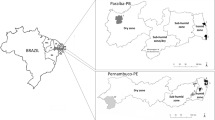Abstract
A comprehensive survey on the prevalence and incidence of Verticillium wilt of olive in Turkey has been conducted over 6 years (2003–2008). Vegetative compatibility group (VCG) assessment and PCR-based molecular pathotyping were used to evaluate the distribution of the defoliating (D) and nondefoliating (ND) pathotypes of Verticillium dahliae in surveyed areas. Pathogen prevalence was 35% of all olive orchards inspected and incidence of the disease reached 3.1%. VCG1A was predominant (29.3%) and infected all major cultivars grown in Turkey. The other two VCGs detected (2A and 4B) were of minor relevance (4.9% and 0.9%, respectively). Disease incidence caused by VCG1A infections was higher (ranging from 1.1% to 6.9%) than that caused by VCG2A and VCG4B in 10 provinces (Manisa, Aydin, Kahramanmaras, Izmir, Mugla, Kilis, Denizli, Gaziantep, Mardin and Balikesir). However, VCG2A and 4B were more prevalent (and responsible for higher disease incidence) than VCG1A in three provinces (Hatay, Osmaniye and Bursa). Finally, VCG1A isolates were found in all provinces except Canakkale, and simultaneous presence of the three VCGs was only verified in Hatay province. An artificial inoculation bioassay (19 representative V. dahliae isolates included) revealed that VCG1A (13) isolates as a group were more aggressive and caused defoliation, whereas VCG2A (5) and VCG4B (1) isolates induced milder symptoms. Within a VCG group, virulence varied among isolates infecting the same olive cultivar and this virulence was also related to the differential susceptibility of the cultivars (‘Manzanilla’, ‘Ayvalik’ and ‘Gemlik’) tested. Molecular pathotyping allowed the identification of D (VCG1A) and ND (VCG2A/4B) pathotypes, which correlated with results from pathogenicity tests. Remarkably, the V. dahliae VCG1A/D pathotype population infecting olive in Turkey was molecularly different from that one previously identified in Spain.


Similar content being viewed by others
References
Bejarano-Alcázar, J., Blanco-López, M. A., Melero-Vara, J. M., & Jiménez-Díaz, R. M. (1995). Influence of inoculum density of defoliating and nondefoliating patothypes of Verticillium dahliae in epidemics of Verticillium wilt of cotton in southern Spain. Phytopathology, 85, 1474–1481.
Carder, J. H., Morton, A., Tabrett, A. M., & Barbara, D. J. (1994). Detection and differentiation by PCR of subspecific groups within two Verticillium species causing vascular wilts in herbaceous hosts. In A. Schots, F. M. Dewey, & R. Oliver (Eds.), Modern assays for plant pathogenic fungi (pp. 91–97). Oxford: CAB International.
Cherrab, M., Bennani, A., Charest, P. M., & Serrhini, M. N. (2002). Pathogenicity and vegetative compatibility of Verticillium dahliae isolates from olive in Morocco. Journal of Phytopathology, 84, 703–709.
Colella, C., Miacola, C., Amenduni, M., D’Amico, M., Bubici, G., & Cirulli, M. (2008). Sources of Verticillium wilt resistance in wild olive germplasm from the Mediterranean region. Plant Pathology, 57, 533–539.
Collado-Romero, M., Mercado-Blanco, J., Olivares-García, C., Valverde-Corredor, A., & Jiménez-Díaz, R. M. (2006). Molecular variability within and among Verticillium dahliae vegetative compatibility groups determined by fluorescent amplified fragment length polymorphism and polymerase chain reaction markers. Phytopathology, 96, 485–495.
Correll, J. C., Klittich, C. J. R., & Leslie, J. F. (1987). Nitrate nonutilizing mutants of Fusarium oxysporum and their use in vegetative compatibility tests. Phytopathology, 77, 1640–1646.
Dervis, S., & Bicici, M. (2005). Vegetative compatibility groups in Verticillium dahliae isolates from cotton in Turkey. Phytoparasitica, 33, 157–168.
Dervis, S., Erten, L., Soylu, S., Tok, F. M., Kurt, S., Yildiz, M., et al. (2007). Vegetative compatibility groups in Verticillium dahliae isolates from olive in Western Turkey. European Journal of Plant Pathology, 119, 437–447.
Dervis, S., Kurt, S., Soylu, S., Erten, L., Soylu, E. M., Yildiz, M., et al. (2008). Vegetative compatibility groups of Verticillium dahliae from cotton in the Southeastern Anatolia region of Turkey. Phytoparasitica, 36, 74–83.
Erten, L. (2004). Determination of susceptibility of some olive and rootstocks against Verticillium wilt (Verticillium dahliae Kleb.). Ph.D. Thesis, Aegean University, Turkey.
Göre, E. (2007). Vegetative compatibility and pathogenicity of Verticillium dahliae isolates from the Aegean Region of Turkey. Phytoparasitica, 35, 222–231.
Jiménez-Díaz, R. M., Tjamos, E. C., & Cirulli, M. (1998). Verticillium wilts of major tree hosts. In J. Hiemstra & D. Harris (Eds.), Compendium of Verticillium wilt in tree species (pp. 55–57). Wageningen: Ponsen and Looijen.
Joaquim, T. R., & Rowe, R. C. (1990). Reassessment of vegetative compatibility relationships among strains of Verticillium dahliae using nitrate-nonutilizing mutants. Phytopathology, 80, 1160.
Katan, T. (2000). Vegetative compatibility in populations of Verticillium—an overview. In E. C. Tjamos, R. C. Rowe, J. B. Heale, & D. R. Fravel (Eds.), Advances in Verticillium research and disease management (pp. 69–86). St. Paul: APS.
Korolev, N., & Katan, T. (1997). Improved medium for selecting nitrate nonutilizing (nit) mutants of Verticillium dahliae. Phytopathology, 87, 1067–1070.
Korolev, N., Katan, J., & Katan, T. (2000). Vegetative compatibility groups of Verticillium dahliae in Israel: their distribution and association with pathogenicity. Phytopathology, 90, 529–566.
Korolev, N., Pérez-Artés, E., Bejarano-Alcázar, J., Rodríguez-Jurado, D., Katan, J., Katan, T., et al. (2001). Comparative study of genetic diversity and pathogenicity among populations of Verticillium dahliae from cotton in Spain and Israel. European Journal of Plant Pathology, 107, 443–456.
Korolev, N., Pérez-Artés, E., Mercado-Blanco, J., Bejarano-Alcázar, J., Rodríguez-Jurado, D., Jiménez-Díaz, R. M., et al. (2008). Vegetative compatibility of cotton defoliating Verticillium dahliae in Israel and its pathogenicity to various hosts. European Journal of Plant Pathology, 122, 603–617.
López-Escudero, F. J., & Blanco-López, M. A. (2001). Effect of a single or double soil solarization to control Verticillium wilt in established olive orchards in Spain. Plant Disease, 85, 489–496.
López-Escudero, F. J., del Río, C., Caballero, J. M., & Blanco-López, M. A. (2004). Evaluation of olive cultivars for resistance to Verticillium dahliae. European Journal of Plant Pathology, 110, 79–85.
Mercado-Blanco, J., Rodríguez-Jurado, D., Pérez-Artés, E., & Jiménez-Díaz, R. M. (2001). Detection of the nondefoliating pathotype of Verticillium dahliae in infected olive plants by nested PCR. Plant Pathology, 50, 609–619.
Mercado-Blanco, J., Rodríguez-Jurado, D., Pérez-Artés, E., & Jiménez-Díaz, R. M. (2002). Detection of the defoliating pathotype of Verticillium dahliae in infected olive plants by nested-PCR. European Journal of Plant Pathology, 108, 1–13.
Mercado-Blanco, J., Rodríguez-Jurado, D., Parrilla-Araujo, S., & Jiménez-Díaz, R. M. (2003). Simultaneous detection of the defoliating and nondefoliating Verticillium dahliae pathotypes in infected olive plants by duplex, nested polymerase chain reaction. Plant Disease, 87, 1487–1494.
Navas Cortés, J. A., Landa, B. B., Mercado-Blanco, J., Trapero-Casas, J. L., Rodríguez-Jurado, D., & Jiménez-Díaz, R. M. (2008). Spatiotemporal analysis of spread of infections by Verticillium dahliae pathotypes within a high tree density olive orchard in Southern Spain. Phytopathology, 98, 167–180.
Owen, C. A., Bita, E. C., Banilas, G., Hajjar, S. E., Sellianakis, V., Aksoy, U., et al. (2005). AFLP reveals structural details of genetic diversity within cultivated olive germplasm from the Eastern Mediterranean. Theoretical and Applied Genetics, 110, 1169–1176.
Pérez-Artés, E., García-Pedrajas, M. D., Bejarano-Alcázar, J., & Jiménez-Díaz, R. M. (2000). Differentiation of cotton-defoliating and nondefoliating pathotypes of Verticillium dahliae by RAPD and specific PCR analyses. European Journal of Plant Pathology, 106, 507–517.
Rodríguez, E., García, P. A., García-Garrido, J. M., García, P. A., & Campos, M. (2008). Agricultural factors affecting Verticillium wilt in olive orchards in Spain. European Journal of Plant Pathology, 122, 287–295.
Rodríguez-Jurado, D. (1993). Interacciones huésped-parásito en la Verticilosis del olivo (Olea europaea L.) inducida por Verticillium dahliae Kleb. PhD Thesis, University of Córdoba, Spain.
Rowe, R. C. (1995). Recent progress in understanding relationships between Verticillium species and subspecific groups. Phytoparasitica, 23, 31–38.
Saydam, C., & Copcu, M. (1972). Verticillium wilt of olives in Turkey. Journal of Turkish Phytopathology, 9, 235–252.
Tjamos, E. C. (1993). Prospects and strategies in controlling Verticillium wilt of olives. Bulletin OEPP/EPPO Bulletin, 23, 505–512.
Truett, G. E., Heeger, P., Mynatt, R. L., Truett, A. A., Walker, J. A., & Warman, M. L. (2000). Preparation of PCR-quality mouse genomic DNA with hot sodium hydroxide and Tris (HotSHOT). BioTechniques, 29, 52–54.
Tsror, L., & Levin, A. G. (2003). Vegetative compatibility and pathogenicity of Verticillium dahliae Kleb. isolates from olive in Israel. Journal of Phytopathology, 151, 451–455.
ZAE. (2008). Olive Research Institute Statistical Database, http://www.zae.gov.tr/.
Acknowledgements
This study was partially supported by The Scientific and Technical Research Council of Turkey (TUBITAK).
Author information
Authors and Affiliations
Corresponding authors
Rights and permissions
About this article
Cite this article
Dervis, S., Mercado-Blanco, J., Erten, L. et al. Verticillium wilt of olive in Turkey: a survey on disease importance, pathogen diversity and susceptibility of relevant olive cultivars. Eur J Plant Pathol 127, 287–301 (2010). https://doi.org/10.1007/s10658-010-9595-z
Accepted:
Published:
Issue Date:
DOI: https://doi.org/10.1007/s10658-010-9595-z




